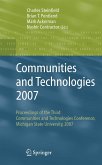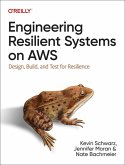Elsa Negre
Information and Recommender Systems
Elsa Negre
Information and Recommender Systems
- Broschiertes Buch
- Merkliste
- Auf die Merkliste
- Bewerten Bewerten
- Teilen
- Produkt teilen
- Produkterinnerung
- Produkterinnerung
Information is an element of knowledge that can be stored, processed or transmitted. It is linked to concepts of communication, data, knowledge or representation. In a context of steady increase in the mass of information it is difficult to know what information to look for and where to find them.
Andere Kunden interessierten sich auch für
![Communities and Technologies 2007 Communities and Technologies 2007]() Charles Steinfield / Brian Pentland / Mark Ackerman / Noshir Contractor (eds.)Communities and Technologies 2007172,99 €
Charles Steinfield / Brian Pentland / Mark Ackerman / Noshir Contractor (eds.)Communities and Technologies 2007172,99 €![Engineering Resilient Systems on AWS Engineering Resilient Systems on AWS]() Kevin SchwarzEngineering Resilient Systems on AWS62,99 €
Kevin SchwarzEngineering Resilient Systems on AWS62,99 €![Recommender Systems Recommender Systems]() Dietmar JannachRecommender Systems83,99 €
Dietmar JannachRecommender Systems83,99 €![The Shelly Cashman Series Microsoft Office 365 & Outlook 2021 Comprehensive The Shelly Cashman Series Microsoft Office 365 & Outlook 2021 Comprehensive]() Corinne Hoisington (Central Virginia Community College)The Shelly Cashman Series Microsoft Office 365 & Outlook 2021 Comprehensive98,99 €
Corinne Hoisington (Central Virginia Community College)The Shelly Cashman Series Microsoft Office 365 & Outlook 2021 Comprehensive98,99 €![UX for AI UX for AI]() Greg Nudelman (Inc DesignCaffeine)UX for AI36,99 €
Greg Nudelman (Inc DesignCaffeine)UX for AI36,99 €![SAP S/4hana Supply Chain Planning and Manufacturing SAP S/4hana Supply Chain Planning and Manufacturing]() Agrawal AgrawalSAP S/4hana Supply Chain Planning and Manufacturing37,99 €
Agrawal AgrawalSAP S/4hana Supply Chain Planning and Manufacturing37,99 €![AWS for Non-Engineers AWS for Non-Engineers]() Hiroko NishimuraAWS for Non-Engineers37,99 €
Hiroko NishimuraAWS for Non-Engineers37,99 €-
-
-
Information is an element of knowledge that can be stored, processed or transmitted. It is linked to concepts of communication, data, knowledge or representation. In a context of steady increase in the mass of information it is difficult to know what information to look for and where to find them.
Produktdetails
- Produktdetails
- Verlag: ISTE Ltd and John Wiley & Sons Inc
- Seitenzahl: 96
- Erscheinungstermin: 12. Oktober 2015
- Englisch
- Abmessung: 234mm x 156mm x 5mm
- Gewicht: 164g
- ISBN-13: 9781848217546
- ISBN-10: 1848217544
- Artikelnr.: 42056047
- Herstellerkennzeichnung
- Libri GmbH
- Europaallee 1
- 36244 Bad Hersfeld
- gpsr@libri.de
- Verlag: ISTE Ltd and John Wiley & Sons Inc
- Seitenzahl: 96
- Erscheinungstermin: 12. Oktober 2015
- Englisch
- Abmessung: 234mm x 156mm x 5mm
- Gewicht: 164g
- ISBN-13: 9781848217546
- ISBN-10: 1848217544
- Artikelnr.: 42056047
- Herstellerkennzeichnung
- Libri GmbH
- Europaallee 1
- 36244 Bad Hersfeld
- gpsr@libri.de
Elsa Negro has a PhD in computer science and is professor at Paris-Dauphine University, France. She is particularly interested in decision-making information systems, recommendation systems, intelligent digital cities and crisis management.
Introduction vii
Chapter 1. A Few Important Details Before We Begin 1
1.1. Information systems 1
1.2. Decision support systems 2
1.3. Recommender systems 3
1.4. Comparisons 4
1.5. Recommendation versus personalization 5
1.5.1. Recommendation 5
1.5.2. Personalization 6
Chapter 2. Recommender Systems 7
2.1. Introduction 8
2.2. Classification of recommender systems 9
2.2.1. Classification by score estimation method 9
2.2.2. Classification by data exploitation 10
2.2.3. Classification by objective 11
2.3. User profiles 11
2.4. Data mining 12
2.5. Content-based approaches 14
2.6. Collaborative filtering approaches 17
2.7. Knowledge-based approaches 20
2.8. Hybrid approaches 23
2.9. Other approaches 25
Chapter 3. Key Concepts, Useful Measures and Techniques 29
3.1. Vector space model 31
3.2. Similarity measures 31
3.2.1. Cosine similarity 31
3.2.2. Pearson correlation coefficient 32
3.2.3. Euclidean distance 33
3.2.4. Dice index 33
3.3. Dimensionality reduction 34
3.3.1. Principal component analysis 34
3.3.2. Singular value decomposition 35
3.3.3. Latent semantic analysis 36
3.4. Classification/clustering 36
3.4.1. Classification 36
3.4.2. Clustering 37
3.5. Other techniques 39
3.5.1. Term frequency-inverse document frequency (TF-IDF) 39
3.5.2. Association rules 40
3.6. Comparisons 41
Chapter 4. Practical Implementations 43
4.1. Commercial applications 43
4.1.1. Amazon.com 43
4.1.2. Netflix 45
4.2. Databases 46
4.3. Collaborative environments 48
4.4. Smart cities 49
4.5. Early warning systems 54
Chapter 5. Evaluating the Quality of Recommender Systems 57
5.1. Data sets, sparsity and errors 57
5.2. Measures 59
5.2.1. Accuracy 59
5.2.2. Other measures 63
Conclusion 65
Bibliography 67
Index 77
Chapter 1. A Few Important Details Before We Begin 1
1.1. Information systems 1
1.2. Decision support systems 2
1.3. Recommender systems 3
1.4. Comparisons 4
1.5. Recommendation versus personalization 5
1.5.1. Recommendation 5
1.5.2. Personalization 6
Chapter 2. Recommender Systems 7
2.1. Introduction 8
2.2. Classification of recommender systems 9
2.2.1. Classification by score estimation method 9
2.2.2. Classification by data exploitation 10
2.2.3. Classification by objective 11
2.3. User profiles 11
2.4. Data mining 12
2.5. Content-based approaches 14
2.6. Collaborative filtering approaches 17
2.7. Knowledge-based approaches 20
2.8. Hybrid approaches 23
2.9. Other approaches 25
Chapter 3. Key Concepts, Useful Measures and Techniques 29
3.1. Vector space model 31
3.2. Similarity measures 31
3.2.1. Cosine similarity 31
3.2.2. Pearson correlation coefficient 32
3.2.3. Euclidean distance 33
3.2.4. Dice index 33
3.3. Dimensionality reduction 34
3.3.1. Principal component analysis 34
3.3.2. Singular value decomposition 35
3.3.3. Latent semantic analysis 36
3.4. Classification/clustering 36
3.4.1. Classification 36
3.4.2. Clustering 37
3.5. Other techniques 39
3.5.1. Term frequency-inverse document frequency (TF-IDF) 39
3.5.2. Association rules 40
3.6. Comparisons 41
Chapter 4. Practical Implementations 43
4.1. Commercial applications 43
4.1.1. Amazon.com 43
4.1.2. Netflix 45
4.2. Databases 46
4.3. Collaborative environments 48
4.4. Smart cities 49
4.5. Early warning systems 54
Chapter 5. Evaluating the Quality of Recommender Systems 57
5.1. Data sets, sparsity and errors 57
5.2. Measures 59
5.2.1. Accuracy 59
5.2.2. Other measures 63
Conclusion 65
Bibliography 67
Index 77
Introduction vii
Chapter 1. A Few Important Details Before We Begin 1
1.1. Information systems 1
1.2. Decision support systems 2
1.3. Recommender systems 3
1.4. Comparisons 4
1.5. Recommendation versus personalization 5
1.5.1. Recommendation 5
1.5.2. Personalization 6
Chapter 2. Recommender Systems 7
2.1. Introduction 8
2.2. Classification of recommender systems 9
2.2.1. Classification by score estimation method 9
2.2.2. Classification by data exploitation 10
2.2.3. Classification by objective 11
2.3. User profiles 11
2.4. Data mining 12
2.5. Content-based approaches 14
2.6. Collaborative filtering approaches 17
2.7. Knowledge-based approaches 20
2.8. Hybrid approaches 23
2.9. Other approaches 25
Chapter 3. Key Concepts, Useful Measures and Techniques 29
3.1. Vector space model 31
3.2. Similarity measures 31
3.2.1. Cosine similarity 31
3.2.2. Pearson correlation coefficient 32
3.2.3. Euclidean distance 33
3.2.4. Dice index 33
3.3. Dimensionality reduction 34
3.3.1. Principal component analysis 34
3.3.2. Singular value decomposition 35
3.3.3. Latent semantic analysis 36
3.4. Classification/clustering 36
3.4.1. Classification 36
3.4.2. Clustering 37
3.5. Other techniques 39
3.5.1. Term frequency-inverse document frequency (TF-IDF) 39
3.5.2. Association rules 40
3.6. Comparisons 41
Chapter 4. Practical Implementations 43
4.1. Commercial applications 43
4.1.1. Amazon.com 43
4.1.2. Netflix 45
4.2. Databases 46
4.3. Collaborative environments 48
4.4. Smart cities 49
4.5. Early warning systems 54
Chapter 5. Evaluating the Quality of Recommender Systems 57
5.1. Data sets, sparsity and errors 57
5.2. Measures 59
5.2.1. Accuracy 59
5.2.2. Other measures 63
Conclusion 65
Bibliography 67
Index 77
Chapter 1. A Few Important Details Before We Begin 1
1.1. Information systems 1
1.2. Decision support systems 2
1.3. Recommender systems 3
1.4. Comparisons 4
1.5. Recommendation versus personalization 5
1.5.1. Recommendation 5
1.5.2. Personalization 6
Chapter 2. Recommender Systems 7
2.1. Introduction 8
2.2. Classification of recommender systems 9
2.2.1. Classification by score estimation method 9
2.2.2. Classification by data exploitation 10
2.2.3. Classification by objective 11
2.3. User profiles 11
2.4. Data mining 12
2.5. Content-based approaches 14
2.6. Collaborative filtering approaches 17
2.7. Knowledge-based approaches 20
2.8. Hybrid approaches 23
2.9. Other approaches 25
Chapter 3. Key Concepts, Useful Measures and Techniques 29
3.1. Vector space model 31
3.2. Similarity measures 31
3.2.1. Cosine similarity 31
3.2.2. Pearson correlation coefficient 32
3.2.3. Euclidean distance 33
3.2.4. Dice index 33
3.3. Dimensionality reduction 34
3.3.1. Principal component analysis 34
3.3.2. Singular value decomposition 35
3.3.3. Latent semantic analysis 36
3.4. Classification/clustering 36
3.4.1. Classification 36
3.4.2. Clustering 37
3.5. Other techniques 39
3.5.1. Term frequency-inverse document frequency (TF-IDF) 39
3.5.2. Association rules 40
3.6. Comparisons 41
Chapter 4. Practical Implementations 43
4.1. Commercial applications 43
4.1.1. Amazon.com 43
4.1.2. Netflix 45
4.2. Databases 46
4.3. Collaborative environments 48
4.4. Smart cities 49
4.5. Early warning systems 54
Chapter 5. Evaluating the Quality of Recommender Systems 57
5.1. Data sets, sparsity and errors 57
5.2. Measures 59
5.2.1. Accuracy 59
5.2.2. Other measures 63
Conclusion 65
Bibliography 67
Index 77








